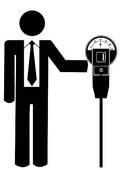March 15, 2012 New Yorl Times
A Meter So Expensive, It Creates Parking Spots
By Michael Cooper and Jo Craven McGinty
SAN FRANCISCO — The maddening quest for street parking is not just a tribulation for drivers, but a trial for cities. As much as a third of the traffic in some areas has been attributed to drivers circling as they hunt for spaces. The wearying tradition takes a toll in lost time, polluted air and, when drivers despair, double-parked cars that clog traffic even more.
But San Francisco is trying to shorten the hunt with an ambitious experiment that aims to make sure that there is always at least one empty parking spot available on every block that has meters. The program, which uses new technology and the law of supply and demand, raises the price of parking on the city’s most crowded blocks and lowers it on its emptiest blocks. While the new prices are still being phased in — the most expensive spots have risen to $4.50 an hour, but could reach $6 — preliminary data suggests that the change may be having a positive effect in some areas.
Change can already be seen on a stretch of Drumm Street downtown near the Embarcadero and the popular restaurants at the Ferry Building. Last summer it was nearly impossible to find spots there. But after the city gradually raised the price of parking to $4.50 an hour from $3.50, high-tech sensors embedded in the street showed that spots were available a little more often — leaving a welcome space the other day for the silver Toyota Corolla driven by Victor Chew, a salesman for a commercial dishwasher company who frequently parks in the area.
“There are more spots available now,” said Mr. Chew, 48. “Now I don’t have to walk half a mile.”
San Francisco’s parking experiment is the latest major attempt to improve the uneasy relationship between cities and the internal combustion engine — a century-long saga that has seen cities build highways and tear them down, widen streets and narrow them, and make more parking available at some times and discourage it at others, all to try to make their downtowns accessible but not too congested.
The program here is being closely watched by cities around the country. With the help of a federal grant, San Francisco installed parking sensors and new meters at roughly a quarter of its 26,800 metered spots to track when and where cars are parked. And beginning last summer, the city began tweaking its prices every two months — giving it the option of raising them 25 cents an hour, or lowering them by as much as 50 cents — in the hope of leaving each block with at least one available spot. The city also has cut prices at many of the garages and parking lots it manages, to lure cars off the street.
It is too early to tell whether the program is working over all, but an analysis of city parking data by The New York Times found signs that the new rates are having the desired effect in some areas. While only a third of the blocks in the program have hit their targeted occupancy rates in any given month since the program began, the analysis found, three-quarters of the blocks either hit their targets or moved closer to the goal. The program has been a bit more successful on weekdays.
Of course, price is only one factor that influences behavior. About a fifth of the time prices rose but more spaces filled up, or prices fell but fewer people parked. And the full effects of the phased-in price changes have yet to be felt, because the most expensive spots cannot hit the $6-an-hour maximum until next year at the earliest.
Jay Primus, who manages the program for the San Francisco Municipal Transportation Agency, said city was trying to reduce traffic and pollution and make parking easier — and not just to raise revenues. “We only need a few people to see there is a price difference and choose to park in a different location to open up just a few spaces here and there,” he said.
Meters here can now charge different prices at different times of the day, and the city has lengthened or eliminated time limits. Since the city made it easier to pay for parking with credit cards, and began a program that allows people to find spots and pay for them on their mobile phones — so they no longer have to run out of meals to feed the meters — fewer parking tickets have been issued.
The program is the biggest test yet of the theories of Donald Shoup, a professor of urban planning at the University of California, Los Angeles. His 2005 book, “The High Cost of Free Parking,” made him something of a cult figure to city planners — a Facebook group, The Shoupistas, has more than a thousand members. “I think the basic idea is that we will see a lot of benefits if we get the price of curbside parking right, which is the lowest price a city can charge and still have one or two vacant spaces available on every block,” he said.
But raising prices is rarely popular. A chapter in Mr. Shoup’s book opens with a quote from George Costanza, the “Seinfeld” character: “My father didn’t pay for parking, my mother, my brother, nobody. It’s like going to a prostitute. Why should I pay when, if I apply myself, maybe I can get it for free?” Some San Francisco neighborhoods recently objected to a proposal to install meters on streets where parking is now free. And raising prices in the most desirable areas raises concerns that it will make them less accessible to the poor.
That was on the minds of some parkers on Drumm Street, where the midday occupancy rate on one block fell to 86 percent from 98 percent after prices rose. Edward Saldate, 55, a hairstylist who paid nearly $17 for close to four hours of parking there, called it “a big rip-off.”
Tom Randlett, 69, an accountant, said that he was pleased to be able to find a spot there for the first time, but acknowledged that the program was “complicated on the social equity level.”
Officials note that parking rates are cut as often as they are raised. And Professor Shoup said that the program would benefit many poor people, including the many San Franciscans who do not have cars, because all parking revenues are used for mass transit and any reduction in traffic will speed the buses many people here rely on. And he imagined a day when drivers will no longer attribute good parking spots to luck or karma.
“It will be taken for granted,” he said, “the way you take it for granted that when you go to a store you can get fresh bananas or apples.”
Michael Cooper reported from San Francisco, and Jo Craven McGinty from New York. Malia Wollan contributed reporting from San Francisco.

Citizens Taking Action
for advancement of transit and trains

"the most expensive spots have risen to $4.50 an hour, but could reach $6 ... all parking revenues are used for mass transit and any reduction in traffic will speed the buses many people here rely on."
